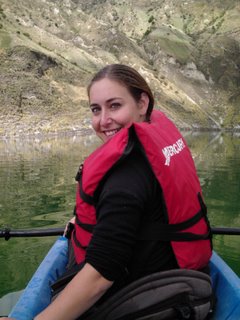
Maya Mahanaymi: volunteer report of a volunteer from Israel in Quilotoa
Quilotoa:
Day1- we get to Quilotoa around six, and the sun was going down. When I say we I mean Emma (another volunteer) and me. We came from Zumbahuwa in a truck (camyoneta), and though we bargained the price down to half, we still paid about five times what the local people pay… well, well…
We got off in Ponce, where we thought the families house was suppose to be, but when we ask the guys that came with us where the house of Cecar is, they tell us that it is in Quilotoa – the next village, that is twenty minutes walk up the road. The only problem was that I had my twenty kilos bag on my back and could barley move forwards. When we got to Quilotoa, we asked again where the house of Cecar was, and we were told that the volunteers sleep in a house nearby. We got there, and it turned out to be a hostel, and had nothing to do with Ecotrackers. But we were so tired so we decided to stay there for the night. The night here is very cold, and we slept in one bed, with seven blankets over us.
Day2- We got up pretty early, to do a trip around the lake before Emma has to go and also before it gets too hot. The volcano rim is only a minute walk from the hostel. When we get to the edge a breathtaking site is revealed in front of us. The lagoon is beautiful in its strong blue-green color.
We decide to walk around, but as an hour goes by and we haven't come far, we decide to go down to the lagoon. We're almost down when we find out there is a dead end (or maybe a deadly end) to the path we took, so we have to climb up and take another one…but in the end we get safely down.
In the lagoon we take a canoe ride around, and as good lazy tourist we do the return trip on horseback.
The people here are really beautiful. Especially the girls, they wear clothes in so many strong colors. It really is, as Max called it, heaven for photographers. There is also lots of art here, and especially traditional drawings of the lagoon and the area.
At noon Emma has to take the bus back to Quito, and I'm going to meet Cecar.
He comes to meet me, and takes me to his brother's house.
The houses here are made from cement, and not of wood as in the jungle or Esmeraldas (my two first volunteer experiences), and there are no pictures on the wall. In comparison to all the colors of the nature and the people here, the houses are very plain.